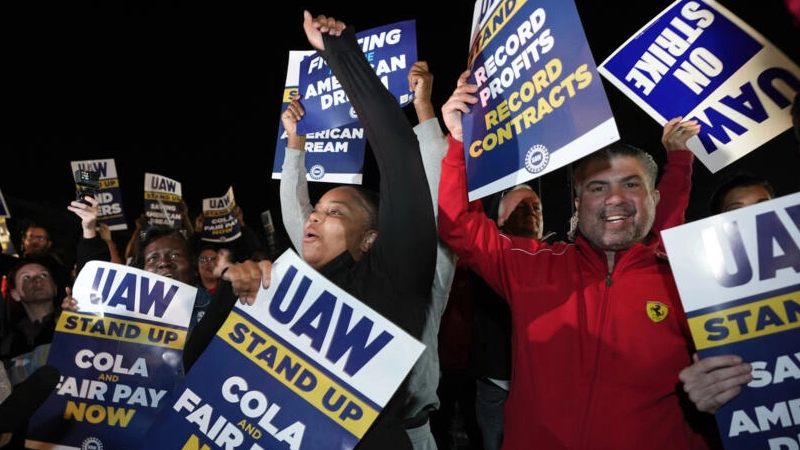In a historic turn of events, approximately 13,000 auto workers across the United States have brought vehicle production to a grinding halt as they demand higher wages, the return of pensions, and better cost-of-living increases.
The strike, which began on Friday, marks the first time in the 88-year history of the United Auto Workers (UAW) that all three major automakers - General Motors (GM), Ford, and Stellantis (formerly Fiat Chrysler) - face simultaneous walkouts as previous contracts expired.
This strike comes at a critical juncture for the American auto industry, as it undergoes a monumental shift from traditional internal combustion vehicles to electric vehicles (EVs). The outcome of this labor dispute could significantly impact the trajectory of the union and the future of America's auto manufacturing sector.
Union flexing Its muscles
The UAW, under the leadership of its new president, Shawn Fain, has opted for a unique strategy this time. Instead of targeting one company, they have simultaneously struck at all three major automakers.
The union's demands are ambitious, with a 36% wage increase over four years at the forefront. However, GM and Ford have offered 20% and 17.5%, respectively.
Workers on strike are making their voices heard. Britney Johnson, a Ford employee, expressed her desire for higher pay and the revival of pensions, saying, "I like the job.
It's just that we deserve more." Adelisa LeBron, a single mother working on the engine line, highlighted the financial strain, stating, "With what I'm making, I have to work a part-time job to make ends meet."
Union's calculated move
The UAW's decision to target only select factories is a strategic one aimed at preserving the union's $825 million strike fund.
If all 146,000 workers joined the strike, the fund would run dry in approximately 11 weeks. However, Fain has not ruled out expanding the strike if the automakers fail to improve their offers.
Fain and the UAW argue that the automakers are making substantial profits and can afford the proposed increases. They dismiss company claims that higher wages would lead to raised vehicle prices, contending that labor costs account for only a small fraction of vehicle expenses. Fain firmly asserts, "We're not the problem. Corporate greed is the problem."
Demands beyond wages
Beyond wage increases, the union seeks the restoration of cost-of-living raises, an end to wage tiers for factory jobs, a 32-hour workweek with 40 hours of pay, and a return to traditional defined-benefit pensions for new hires, who currently receive 401(k)-style retirement plans. The workers also want job security in the growing EV battery manufacturing sector.
The strikes have the potential to significantly disrupt vehicle production, leading to possible shortages and price increases for consumers. Moreover, they could have implications for next year's presidential election, testing President Joe Biden's claim to be the most union-friendly president in American history.
Automakers argue that they are already facing unprecedented challenges as they transition to EVs while continuing to manufacture gas-powered vehicles.
They are concerned that rising labor costs could force them to increase car prices, making them less competitive against foreign automakers with U.S. factories.
Uncertain duration
The strikes have raised uncertainty in the auto industry, with experts predicting that they could last longer than previous work stoppages. Stellantis, with ample inventory, might hold out the longest, while Ford and GM have fewer days of supply. However, both sides are well aware that a prolonged strike could carry significant risks and consequences for all parties involved.
This labor dispute will undoubtedly be closely watched not only by auto industry stakeholders but also by workers, unions, and policymakers across the country, as it unfolds against the backdrop of a changing automotive landscape and a labor force asserting its demands for better pay and benefits.



























